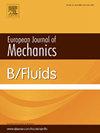A novel transformation free nonuniform higher order compact finite difference scheme for solving incompressible flows on circular geometries
IF 2.5
3区 工程技术
Q2 MECHANICS
引用次数: 0
Abstract
This paper presents a newly developed higher order compact scheme that is designed on a polar grid by using an implicit form of first order derivatives on nonuniform grids. These derivatives are formulated compactly and implicitly with a relationship of the coefficients in terms of the unknown variables. The proposed scheme is free from transformation technique and third order accurate in space. The objective is to solve Stokes equations and Navier–Stokes equations on curvilinear grids using the polar nature of the coordinate system. Our newly developed scheme is used to solve several problems namely, a problem having an analytical solution, Stokes flow with different orientations of the lids for the half filled annular and wedge cavity, the lid driven polar cavity flow and flow past an impulsively started circular cylinder. Our newly developed scheme is used to analyze the flow structures for the flow governed by different physical control parameters: the cavity radius ratio, the cavity angle and the ratio of the upper and lower lid speeds with rotating coaxial cylinders and Reynolds number for the impulsively started circular cylinder. The Stokes equations and the Navier–Stokes equations are efficiently solved with Dirichlet as well as Neumann boundary conditions. The efficacy and robustness of our proposed scheme are shown through its applicability in all the complex fluid flow problems.
用于求解圆形几何体上不可压缩流动的新型无变换非均匀高阶紧凑有限差分方案
本文介绍了一种新开发的高阶紧凑方案,该方案通过在非均匀网格上使用一阶导数的隐含形式,在极坐标网格上进行设计。这些导数是根据未知变量的系数关系以紧凑和隐含的方式计算的。所提出的方案无需转换技术,在空间上具有三阶精度。我们的目标是利用坐标系的极性来求解曲线网格上的斯托克斯方程和纳维-斯托克斯方程。我们新开发的方案用于解决几个问题,即有解析解的问题、半填满环形和楔形空腔不同方向盖子的斯托克斯流动、盖子驱动的极性空腔流动和经过脉冲启动圆柱体的流动。我们新开发的方案用于分析受不同物理控制参数支配的流动结构:空腔半径比、空腔角度、旋转同轴圆柱体的上下盖速度比以及脉冲启动圆柱体的雷诺数。利用 Dirichlet 和 Neumann 边界条件有效地求解了斯托克斯方程和 Navier-Stokes 方程。我们提出的方案适用于所有复杂的流体流动问题,显示了它的有效性和稳健性。
本文章由计算机程序翻译,如有差异,请以英文原文为准。
求助全文
约1分钟内获得全文
求助全文
来源期刊
CiteScore
5.90
自引率
3.80%
发文量
127
审稿时长
58 days
期刊介绍:
The European Journal of Mechanics - B/Fluids publishes papers in all fields of fluid mechanics. Although investigations in well-established areas are within the scope of the journal, recent developments and innovative ideas are particularly welcome. Theoretical, computational and experimental papers are equally welcome. Mathematical methods, be they deterministic or stochastic, analytical or numerical, will be accepted provided they serve to clarify some identifiable problems in fluid mechanics, and provided the significance of results is explained. Similarly, experimental papers must add physical insight in to the understanding of fluid mechanics.

 求助内容:
求助内容: 应助结果提醒方式:
应助结果提醒方式:


